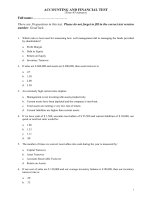4Acids and bases test w solutions
Bạn đang xem bản rút gọn của tài liệu. Xem và tải ngay bản đầy đủ của tài liệu tại đây (69.77 KB, 12 trang )
GENERAL CHEMISTRY TOPICAL:
Acids and Bases
Test 1
Time: 23 Minutes*
Number of Questions: 18
* The timing restrictions for the science topical tests are optional. If
you are using this test for the sole purpose of content
reinforcement, you may want to disregard the time limit.
MCAT
DIRECTIONS: Most of the questions in the following
test are organized into groups, with a descriptive
passage preceding each group of questions. Study the
passage, then select the single best answer to each
question in the group. Some of the questions are not
based on a descriptive passage; you must also select the
best answer to these questions. If you are unsure of the
best answer, eliminate the choices that you know are
incorrect, then select an answer from the choices that
remain. Indicate your selection by blackening the
corresponding circle on your answer sheet. A periodic
table is provided below for your use with the questions.
PERIODIC TABLE OF THE ELEMENTS
1
H
1.0
2
He
4.0
3
Li
6.9
4
Be
9.0
5
B
10.8
6
C
12.0
7
N
14.0
8
O
16.0
9
F
19.0
10
Ne
20.2
11
Na
23.0
12
Mg
24.3
13
Al
27.0
14
Si
28.1
15
P
31.0
16
S
32.1
17
Cl
35.5
18
Ar
39.9
19
K
39.1
20
Ca
40.1
21
Sc
45.0
22
Ti
47.9
23
V
50.9
24
Cr
52.0
25
Mn
54.9
26
Fe
55.8
27
Co
58.9
28
Ni
58.7
29
Cu
63.5
30
Zn
65.4
31
Ga
69.7
32
Ge
72.6
33
As
74.9
34
Se
79.0
35
Br
79.9
36
Kr
83.8
37
Rb
85.5
38
Sr
87.6
39
Y
88.9
40
Zr
91.2
41
Nb
92.9
42
Mo
95.9
43
Tc
(98)
44
Ru
101.1
45
Rh
102.9
46
Pd
106.4
47
Ag
107.9
48
Cd
112.4
49
In
114.8
50
Sn
118.7
51
Sb
121.8
52
Te
127.6
53
I
126.9
54
Xe
131.3
55
Cs
132.9
56
Ba
137.3
57
La *
138.9
72
Hf
178.5
73
Ta
180.9
74
W
183.9
75
Re
186.2
76
Os
190.2
77
Ir
192.2
78
Pt
195.1
79
Au
197.0
80
Hg
200.6
81
Tl
204.4
82
Pb
207.2
83
Bi
209.0
84
Po
(209)
85
At
(210)
86
Rn
(222)
87
Fr
(223)
88
Ra
226.0
89
Ac †
227.0
104
Unq
(261)
105
Unp
(262)
106
Unh
(263)
107
Uns
(262)
108
Uno
(265)
109
Une
(267)
*
58
Ce
140.1
59
Pr
140.9
60
Nd
144.2
61
Pm
(145)
62
Sm
150.4
63
Eu
152.0
64
Gd
157.3
65
Tb
158.9
66
Dy
162.5
67
Ho
164.9
68
Er
167.3
69
Tm
168.9
70
Yb
173.0
71
Lu
175.0
†
90
Th
232.0
91
Pa
(231)
92
U
238.0
93
Np
(237)
94
Pu
(244)
95
Am
(243)
96
Cm
(247)
97
Bk
(247)
98
Cf
(251)
99
Es
(252)
100
Fm
(257)
101
Md
(258)
102
No
(259)
103
Lr
(260)
GO ON TO THE NEXT PAGE.
2
as developed by
Acids and Bases Test 1
Passage I (Questions 1–6)
Geological change occurs on wide-ranging time
scales. Dramatic geologic changes can occur during
extremely brief periods, as with earthquakes, or can take
eons to have a significant effect, such as the slow building
of mountain ranges. While much of this change is due to
physical effects, many geological processes, such as cave
formation, have chemical components. Caves are formed
when limestone rock strata come into contact with
aqueous carbonic acid. This process is described by the
following reactions:
CO2(g) + pressure
H 2O
1 . Which of the following compounds is the major
component of stalagmites?
A.
B.
C.
D.
Ca(HCO3)2
CaCO3
H2CO3
Ca2CO3
CO2(aq)
Reaction 1
CO2(aq) + H2O(l) H2CO3(aq)
Reaction 2
2 . If CaCO3 were water soluble, what would be the
approximate pH of a 1.0 M solution?
A.
B.
C.
D.
3
5
7
8
H2CO3(aq) H+(aq) + HCO3–(aq)
Reaction 3
CaCO3(s) + H+(aq) Ca2+(aq) + HCO3–(aq)
Reaction 4
Carbon dioxide from the atmosphere dissolves in
water according to Reaction 1. At atmospheric pressure
and 25°C, the concentration of dissolved carbon dioxide is
quite low, however, due to the higher pressures possible
in the cracks and fissures of the limestone, the
concentration is much higher. The dissolved carbon
dioxide then reacts with water, forming carbonic acid
(Reaction 2). The carbonic acid dissociates (Reaction 3),
and the acidic hydrogens react with limestone according to
Reaction 4. At some point, the water drains from the
caves, leaving a network of cracks still filled with
dissolved limestone. As the dissolved limestone seeps out
of these cracks and is exposed to the lower pressure of the
cave interior, Reactions 1 through 4 reverse, resulting in
the precipitation of calcium carbonate. If the precipitation
occurs before the drop of dissolved limestone leaves the
cave ceiling, a stalactite forms.
If the precipitate builds-up on the cave floor, a
stalagmite forms.
3 . Many substances that are considered acids contain an
H + ion. Similarly, many bases contain OH– ions.
BCl3, containing neither H + nor OH–, would be
classified as:
A.
B.
C.
D.
a Brønsted base.
a Brønsted acid.
a Lewis base.
a Lewis acid.
4 . If the pKa1 value for H2CO3 is 6.4, what is the pH of
a 10–3 M solution of this acid?
A.
B.
C.
D.
3.0
4.7
6.3
9.3
GO ON TO THE NEXT PAGE.
KAPLAN
3
MCAT
5 . Consider the following acid-base reaction:
HCO3– + HCl
A.
B.
C.
D.
H2CO3 + Cl–
HCl is an acid and HCO3– is its conjugate base.
Cl– is an acid and HCl is its conjugate base.
HCO3– is a base and Cl– is its conjugate acid.
HCO3– is a base and H2CO3 is its conjugate
acid.
6 . Which of the following is a strong acid?
A.
B.
C.
D.
Nitric acid
Phosphoric acid
Carbonic acid
Acetic acid
GO ON TO THE NEXT PAGE.
4
as developed by
Acids and Bases Test 1
Passage II (Questions 7–13)
8 . Which of the following is the strongest acid?
Acids are defined, according to the Arrhenius
definition, as materials that give up a proton when added
to water or reacted with another substance. Since the
proton is always closely associated with at least one water
molecule, it is sometimes written as H3O+. It was once
thought that all acids contained oxygen and, in fact, the
Greek word oxygen means acid-forming. This belief was
refuted with the elemental analysis of hydrochloric acid.
Some acids are almost 100% dissociated: these compounds
are called strong acids. Acids that have a low percentage
ionization are known as weak acids.
A.
B.
C.
D.
9 . What would be the pH of a 0.05 M solution of acetic
acid?
A.
B.
C.
D.
There are literally thousands of compounds that are
acids, most of them weak organic acids. The relative
strength of an acid is indicated by its K a value. The table
below shows the acid dissociation constants for several
common acids.
Table 1
Name
Hydrochloric acid
Acetic acid
Hydrocyanic acid
Oxalic acid
Formula
HCl
HC2H3O2
HCN
H2C2O2
Nitrous acid
Nitric acid
HNO2
HNO3
H2CO3
Carbonic acid
Acidity constant (Ka)
-2 × 10–5
6 × 10–10
K a1 = 6 × 10–2
K a2 = 6 × 10–5
4 × 10–4
-K a1 = 4 × 10–7
Ka2 = 6 × 10–11
Acetic acid
Oxalic acid
Hydrocyanic acid
Nitrous acid
0.05
2.0
3.0
6.0
1 0 . Which of the following correctly represents the
titration curve for oxalic acid when it has been
completely titrated with NaOH?
A.
C.
pH
pH
mL NaOH added
B.
mL NaOH added
D.
pH
pH
7 . Which of the following ions is the conjugate base of
oxalic acid?
A.
B.
C.
D.
HC2O4–
C2O42–
HC2O4+
H3C2O4+
mL NaOH added
mL NaOH added
1 1 . What volume of 0.5 M KOH would be necessary to
neutralize 15 mL of 1.0 M nitrous acid?
A.
B.
C.
D.
30 mL
15 mL
7.5 mL
1.5 mL
GO ON TO THE NEXT PAGE.
KAPLAN
5
MCAT
1 2 . What is the approximate pH when 0.1 moles NaOH
has been added to 0.2 moles hydrocyanic acid?
A.
B.
C.
D.
10.0
9.2
7.0
3.7
1 3 . Which of the following mixtures could be used in a
buffer solution?
A.
B.
C.
D.
HNO3 and NaNO2
HC2H3O2 and HCN
HCl and KCl
NaHCO3 and K2CO3
GO ON TO THE NEXT PAGE.
6
as developed by
Acids and Bases Test 1
Questions 14 through 18 are
NOT based on a descriptive
passage.
1 8 . The titration curve of alanine, an amino acid, is
shown below. The structure of alanine is:
H 3C
CH
COOH
NH2
1 4 . If a buffer solution that contains 0.15 moles NaNO2
and 1.5 moles HNO2 has a pH of 2.4, what will be
the approximate pH after the addition of 0.7 moles
NaOH?
A.
B.
C.
D.
5.4
4.4
3.4
0.7
14
III
pH
7
II
I
0
mL Titrant
1 5 . Which of the following aqueous solutions would have
the lowest pH?
A.
B.
C.
D.
2.0 M
0.5 M
0.3 M
1.8 M
NaCl
HF
HI
NaClO
Which of the combinations below correctly represents
the structures of alanine at points I, II, and III,
respectively?
A.
H3C
CH
COOH
H 3C
NH 2
I
CH
COO–
H3C
CH
NH
III
NH 2
II
COOH
+
3
B.
1 6 . Which of the following aqueous solutions would have
a pH greater than 7.0?
A.
B.
C.
D.
1.0 M HClO
0.5 M NH4CL
0.25 M HCN
0.1 M KCN
H3C
CH
COO –
H 3C
NH
II
NH 2
I
CH
COOH
H 3C
3 × 10–7
3.3 × 108
3.3 × 106
14
CH
NH
II
NH 2
I
A.
B.
C.
D.
H3C
CH
COOH
NH 3
III
+
3
+
C.
H3C
1 7 . If the K a of HClO is 33 × 10–8, the K b value of
ClO– is:
COO–
CH
COO–
H3C
+
3
CH
COOH
NH 3
III
+
D.
H3C
CH
COOH
H 3C
NH 3+
I
CH
NH 3+
II
COO– H3C
CH
COO –
NH 2
III
END OF TEST
KAPLAN
7
MCAT
ANSWER KEY:
1.
B
2.
D
3.
D
4.
B
5.
D
8
6.
7.
8.
9.
10.
A
A
B
C
C
11.
12.
13.
14.
15.
A
B
D
C
C
16.
17.
18.
D
A
D
as developed by
Acids and Bases Test 1
ACIDS AND BASES TEST 1 EXPLANATIONS
Passage I (Questions 1–6)
1.
The correct answer for the first problem is B. This question is largely a reading comprehension-type
question. You are given many hints at the answer throughout the passage. At one point, the passage states that, "caves are
formed when limestone rock strata comes into contact with aqueous carbonic acid." In further describing the process by four
reactions, we can see that only one species is a solid, calcium carbonate. The fact that limestone is calcium carbonate is
further reinforced by the subsequent description of Reaction 4 as "acidic hydrogens reacting with limestone." Later on, the
passage mentions that the reactions reverse and calcium carbonate precipitates. A following sentence says that if this
"precipitate builds-up on the cave floor, a stalagmite forms." The stalagmite must be composed of the precipitate, calcium
carbonate. Thus, the correct answer is B. Answer A is incorrect because calcium hydrogen carbonate is soluble and this is in
fact the soluble product of the dissolution of limestone. Answer C is carbonic acid, which in addition to being incorrect from
the statements in the passage, has never been isolated. Choice D presents an incorrect formula for calcium carbonate. You
should know that metallic elements in the calcium column form +2 ions. Because the carbonate ion has a –2 charge and the
entire molecule is neutral, the charge of each calcium in choice D would be plus 1, an unlikely state. Again the correct
answer is B.
2.
The correct answer for question 2 is D. Since calcium carbonate is a salt of a strong base, calcium
hydroxide, and a weak acid, carbonic acid, it will be basic. You should know that the hydroxides of all Group I and II metals
are strong bases. If you didn't remember that carbonic acid is a weak acid, Reaction 3 should remind you. Reaction 3 shows
that carbonic acid, like any weak acid, is in equilibrium with its ions and does not dissociate completely. Many students find
that because there are many weak acids and only a very few strong acids, if they memorize the strong acids they can assume
all others are weak. In predicting whether a salt will be acidic or basic in solution a simple rule holds: the salt will have the
characteristics of the stronger of the acid and base from which it was hypothetically produced. We can see how this is true
form the example of calcium carbonate. If calcium carbonate dissolved, the calcium ions would not react with the water but
the carbonate ions would pick up hydrogen ions from the water to reestablish the carbonate-hydrogen carbonate-carbonic acid
equilibrium. When hydrogen ions are removed from water the product is hydroxide ions and the solution would become basic.
Only one of the answer choices has a basic pH, a pH greater than 7. Choice D is therefore correct.
3.
The correct answer for problem 3 is choice D. BCl3 has a central boron atom with only 6 electrons. A
Lewis acid by definition is a compound which has fewer electrons than the familiar octet and can, therefore, accept a pair of
electrons from another compound. Choice D is correct. A Lewis base, in contrast, has a pair of unshared electrons and can
donate a pair of electrons. Therefore Lewis acids or bases are defined in terms of their ability to accept or donates an electron
pair. The Brønsted concept is quite different. Brønsted acids and bases are defined in terms of their ability to donate or receive
a proton. A Brønsted acid can donate a proton and usually has an H written first in the formula, which boron trichloride does
not contain. A Brønsted base is a proton acceptor. Though it is less easy to see why boron cannot accept a proton, once
explained it is easily understood. Because a hydronium ion has no electrons and, as mentioned before, boron has only 6
electrons around it, all of which are involved in bonding with the chlorine atoms, none are available to form a boron-hydrogen
bond. Boron trichloride cannot be a proton acceptor and is therefore not a Brønsted base. Again, choice D is the correct
answer.
4.
The correct answer for question 4 is B. You should already be very familiar with the types of calculations
involved in this problem. The pKa of an acid is the negative logarithm of the acidity constant for the acid. To undue this
operation and get the Ka of the acid we take the inverse log, or antilog, of –6.4. Since the negative log of the dissociation
constant is 6.4, the anti-log is 4 ∞ 10–7. (Note: An easy way to estimate anti-logs is as follows: if the log of "X" is equal
to 1, X is equal to 10; if the log of X is 2, X is equal to 100; if the log of X is equal to 3, X is equal to 1000, and so on.
Now for the negative values: if the log of X is equal to –1, X is equal to 0.1; if the log of X is equal to, say, –4, then X is
equal to 0.0001, and so on.) Like all equilibrium constants, the concentrations of products of the reactants appear in the
numerator and the reactants in the denominator. All the stoichiometric coefficients are one in this case and so no exponents
are involved in the expression. In this case, the Ka1 would be the concentration of the hydrogen carbonate ion times the
concentration of the hydrogen ion divided by the concentration of the undissociated carbonic acid. Since the concentrations of
the hydrogen ion and hydrogen carbonate ion are unknown but equal, because they come from the same source, we can give
the concentration of each as x. The concentration of the undissociated carbonic acid is the original concentration, 0.001 moles
per liter, minus the amount that dissociates, x. Putting this all together, the Ka, 4 ∞ 10–7, equals x times x, or x2, over
0.001 molar minus x. To solve this equation we assume x is small compared to 0.001 and so can be ignored. We can say
this is true because carbonic acid is a weak acid and only dissociates to a small extent and as x represents the amount that
dissociates it would be expected to be small proportional to 0.001. This approximation reduces the Ka expression to x2 over
0.001 equals 4 ∞ 10–7. Solving for x by multiplying both sides of the equation by 0.001 and taking the square root of both
sides we find that x is equal to 2 ∞ 10–5. This value of x represents the approximate concentration of both H+ and hydrogen
KAPLAN
9
MCAT
carbonate. Here we only need the hydrogen ion concentration. Since pH is the negative log of the hydrogen ion
concentration, we take the negative log of 2 ∞ 10–5 and find the pH is 4.7. The correct answer is B.
5.
The correct answer for question 5 is D. To solve this problem you must understand what conjugate bases
and acids are. A conjugate acid has one more H+ than the compound with which it is being compared. In other words the
conjugate acid loses a proton to become its conjugate base. In the same way a conjugate base can gain a proton to become its
conjugate acid. Statement A is false because the product of Reaction 4 is calcium hydrogen carbonate not calcium
hydrocarbonate. Statement B is wrong because calcium carbonate cannot act as an acid. Statement C is close but
interchanges the terms. Only choice D is correct. Bicarbonate is a base and is the conjugate acid of carbonate. The correct
answer is D.
6.
The correct answer to question 6 is A. Perhaps the best way to solve a problem like this is to memorize
the few strong acids that are common and assume that all other acids are weak. Some of the most common strong acids
include: sulfuric acid (H2SO4), nitric acid (HNO3), hydrochloric acid (HCl), hydrobromic acid (HBr), hydroiodic acid (HI),
chloric acid (HClO3), and perchloric acid (HClO4). Again the correct answer is A.
Passage II (Questions 7–13)
7.
For question 7, the correct answer is choice A. The conjugate base of a compound is a species which has
one less hydrogen ion and therefore one unit greater negative charge than the original compound. In other words, it is
missing one H+ from the formula of the original compound. The formula given in choice A meets those conditions compared
to the formula of oxalic acid itself. Choice B is the conjugate base of choice A, but is not the conjugate base of oxalic acid,
since it differs by two hydrogen ions from the oxalic acid formula. Choice D is the conjugate acid for oxalic acid, having one
more hydrogen ion than oxalic acid. This might indeed exist. Choice C probably does not exist, as oxalic acid would need to
lose a hydride ion for the charge to be correct. Again, the correct answer is A.
8.
The correct answer for question 8 is B. The strongest acid is the one with the highest K a value. This is
because the larger the Ka value is, the greater extent to which the acid dissociates. For those acids that are multiprotic, that is
have more than one acidic hydrogen that can be removed, only the first of the Ka's contributes significantly to the total acidity
of the acid. For example, because the Ka values for oxalic acids differ by a factor of a thousand, the second proton from oxalic
acid is a thousand times less acidic than the first proton. The significant contributor to the acidity of oxalic acid is the first
proton that comes off. Because the Ka for this first deprotonation is larger than any of the other acid choices, oxalic acid is
the strongest acid among the group. The correct answer is oxalic acid, choice B.
9.
The correct answer for question 9 is C. The solution may be found by knowing how the acidity constant,
or Ka, is defined. The Ka is an equilibrium constant and is defined to be the equilibrium constant for the dissociation process
of an acid. Therefore the acidity constant of acetic acid is the equilibrium constant for the equilibrium between the
undissociated acetic acid, CH3COOH, on the left, and the proton, H+, and acetate, CH3COO− on the right. The Ka, as an
equilibrium constant, therefore equals the product of the concentrations of H+ and acetate divided by the concentration of
undissociated acetic acid. Because the H+ and the acetate come from the same source in equal amounts and there is no other
significant source of either of them there must be equal concentrations of both of these species. We can call the
concentrations of acetate and hydronium ion x since we don't know the value at this point. The numerator in the Ka
expression therefore becomes x ∞ x or x2. The concentration of undissociated acetic acid in the denominator is the original
concentration, 0.05 moles per liter, minus the amount that dissociates, x. The Ka expression now has x2 in the numerator
and 0.05 minus x in the denominator. This expression equals the Ka for acetic acid, which you can see in the table is 2 ∞
10–5. This is a difficult equation to solve algebraically as it is written, so to simplify it and make it easier to solve we make
an approximation. The value of x in the denominator would be expected to be small compared to 0.05. We can say this is
true because acetic acid is a weak acid and only dissociates to a small extent and as x represents the amount that dissociates it
would be expected to be small proportional to 0.05. This approximation reduces the Ka expression to x2 over 0.05 equals 2
∞ 10–5. Solving for x by multiplying both sides of the equation by 0.05 and taking the square root of both sides we find that
x is equal to 1 ∞ 10–3. This value of x represents the approximate concentration of both H+ and acetate. If we needed a more
accurate answer we could substitute this value of x into the denominator and resolve the equation for the value of x in the
numerator. This solution process is called solving by iteration, as a prior answer is substituted in a part of the expression and
a more accurate answer obtained. The accuracy of the solution for this particular question is sufficient. As pH is defined as
the negative log of the hydronium ion concentration, the solution would have a pH of 3. The correct answer is C.
10.
The correct answer for question 10 is C. We can eliminate many of the answers quickly. Oxalic acid, as
it's name would suggest, is an acid, and a solution of it, before any sodium hydroxide were added, would be acidic and the
solution would become more basic as the basic sodium hydroxide was added. Thus curve A is wrong as it begins at a basic
pH and becomes more acidic as titrant is added. If you didn't know it already, you can see that oxalic acid is a weak acid from
10
as developed by
Acids and Bases Test 1
the table of acids in the passage. The titration curve given in D is typical of that of a strong acid titrated by a strong base.
The pH is low and remains that way until it changes rapidly near the equivalence point. Therefore curve D is wrong. Though
they begin at a higher pH than strong acids, weak acids usually have a buffering region where the pH changes slowly but
remains relatively constant as base is added. This occurs because the acid and its conjugate base are in equilibrium. As base
is added and reacts with the hydrogen ion in solution, this equilibrium is disturbed and more undissociated acid ionizes,
releasing more hydrogen ion. The concentration of hydrogen ion in solution therefore remains relatively constant as long as a
significant amount of undissociated acid species remains. The equivalence point is less sharp and distinct than that for a
strong acid as shown in curve D and a typical titration curve of a weak acid with a strong base would instead look like curve
B. We might be tempted to circle answer B now but that is incorrect. Oxalic acid is a diprotic acid, as you might see from
the existence of two Ka values. Oxalic acid would, therefore, have a titration curve with two breaks as each of the acidic
hydrogens is titrated in succession. Thus curve C is correct as it has two breaks characteristic of a diprotic acid and a gradual
change in pH that suggests a weak acid.
11.
The correct answer for question 11 is choice A. In order to solve this problem you should know that the
amount of hydrogen ions provided by the nitrous acid must equal the amount of hydroxide provided by the potassium
hydroxide. Since nitrous acid provide one hydrogen ion per molecule and potassium hydroxide provides one hydroxide per
molecule, the number of moles of potassium hydroxide must equal the number of moles of nitrous acid to completely
neutralize it. Knowing the concentration and the volume of a solution we can calculate the number of moles of the species.
We can set up the following equation: the volume of potassium hydroxide times the concentration of the potassium hydroxide
equals the volume of nitrous acid times the concentration of nitrous acid. The only unknown in this equation is the volume
of potassium hydroxide, which when we solve for it, we find to be 30 mL. The correct answer is therefore A.
12.
The correct answer for question 12 is B. Hydrocyanic acid is a weak acid. When 0.1 moles NaOH has
been added to 0.2 moles of the acid, half of the acid is converted into the salt sodium cyanide. This means that there are
approximately equal amounts of the undissociated acid, HCN, and its conjugate base, the cyanide ion, CN−, from the salt. A
solution containing approximately equal amounts of an acid and its conjugate base is a buffer solution. We can use the
Henderson-Hasselbach equation, which you should memorize, to find the approximate pH for a buffer solution. The
Henderson-Hasselbach equation says that pH of a buffer solution is approximately equal to the pKa of the acid plus the log of
ratio of the concentration of the conjugate base (in our case cyanide) to the acid. The pKa for hydrocyanic acid is 9.2.
However, because half of the hydrocyanic acid has reacted with the sodium hydroxide, the amount of acid and conjugate base
are both 0.1 mol and so the ratio of conjugate base to acid is 1. The log of 1 is zero and so the Henderson-Hasselbach
equation simplifies to pH is approximately equal to pKa. The pH therefore is 9.2 and answer B is correct.
13.
The correct answer for question 13 is D. A buffer solution must contain a weak acid and its conjugate base
or a weak base and its conjugate acid. Buffers are particularly effective where the concentrations of the two species are
approximately equal. A solution of the mixture in answer D would be a buffer. The mixture in choice D consists of a weak
acid, and you should realize from the table that bicarbonate can act as a weak acid, and its conjugate base, the carbonate ion
from potassium carbonate. The fact that the bicarbonate comes from sodium carbonate and carbonate comes from potassium
carbonate should not throw you. Both sodium and potassium do not participate at all in the reactions, they are merely
spectator ions. Choice A consists of a strong acid and, though the nitrite ion is a weak base, and would not make a buffer as
nitric acid is not its conjugate acid. Choice B has a weak acid and the salt of another acid and so the necessary conjugate base
of the weak acid is not present. Choice C is similar to choice A, but though chloride is the conjugate base of hydrochloric
acid, the mixture consists of a strong acid and its salt and cannot be a buffer. Again, the correct answer is D.
Discrete Questions
14.
The correct answer to question 14 is C. Calculations for the pH of a buffer solution may be made using
the Henderson-Hasselbach equation. The equation states that the pH of a buffer solution is approximately equal to the pKa of
the acid plus the log of the ratio of the amount of conjugate base to acid. The pKa of nitrous acid may be found by
substituting in the pH for the original solution, 2.4, and subtracting the log of 0.15 divided by 1.5. The pKa of HNO2 is
then found to be 3.4. This is a constant and never changes. After adding of 0.7 moles of sodium hydroxide, 0.7 moles of
nitrous acid is converted to 0.7 moles of nitrite ion. The new amounts of both of these species is then 1.5 – 0.7, or a total of
0.8 moles of nitrous acid, and 0.15 + 0.7, or 0.85 moles of nitrate ion. Substituting in these new values into the HendersonHasselbach equation with the pKa of nitrous acid as 3.4 we solve for the new pH. The pH is equal to 3.4 plus the log of 0.85
over 0.80, or 3.4. You can see that when the concentrations of the weak acid and its conjugate base are approximately the
same, the pH is equal to the pKa. Thus answer C is correct.
15.
The correct answer for question 15 is choice C. Answer C involves a strong acid, hydroiodic acid, at 0.3
M concentration and would be expected to completely ionize. Choice B, hydrofluoric acid, is a weak acid, which though at a
higher concentration than the hydroiodic acid, would give a lower hydrogen ion concentration and higher pH than the HI. The
salt solution in choice A is the salt of a strong acid and a strong base, which is neutral since neither ion would react with
KAPLAN
11
MCAT
water to produce their conjugates. The salt in choice D is from a strong base and a weak acid, and would, therefore be have a
pH greater than 7, as the hypochlorous ion would pick up hydrogen ions from the water to form its conjugate acid and leave
behind hydroxide ion. Again, answer C is correct.
16.
The correct answer to question 16 is D. The trick, if it could be called that, is understanding what should
happen to each when it is dissolved in water. Choice A is a weak acid, and though the solution would not be as acidic as an
equal concentration of a strong acid, it would still be acidic and therefore incorrect. Choice B is the salt of a weak base,
ammonia, and a strong acid, hydrochloric acid. When dissolved in solution the chloride ion remains in solution but the
ammonium ion establishes a dissociation equilibrium with ammonia and hydrogen ion as products. The hydrogen ion
concentration of the solution therefore increases and it would be expected to be acidic and therefore is a wrong choice. Choice
C is a weak acid and would be expected to be acidic for much the same reason choice A is. Choice D must be the correct
answer because we have eliminated the others, now we must understand why. Potassium cyanide, in addition to being high
poisonous, is the salt of a strong base, potassium hydroxide, and a weak acid, hydrogen cyanide. When the salt dissolves in
water, the potassium ion does not react with water but the cyanide ion picks up hydrogen ion from the water to establish an
equilibrium with hydrocyanic acid. The result is that excess hydroxide ions are created and the solution is basic. Answer D is
correct.
17.
For question 17 the correct answer is A. The relationship that must be satisfied in any aqueous solution is
that the Ka of any acid times the Kb of its conjugate base is equal to 1 x 10–14. This relationship holds for hydroxide and
hydrogen ions as well as all other acids and bases in aqueous solution. This means that the acidity constant for an acid times
the base constant for the conjugate base is equal to the water constant. Putting the acidity constant for hypochlorous acid into
the formula and solving for Kb gives 3 ∞ 10–7. The correct answer is A.
18.
The correct answer for question 18 is D. Alanine is an amino acid and like all amino acids it is
amphoteric, that is it can act as a acid and a base. The amino group would be expected to be protonated in acidic solution and
deprotonated in basic solution. On the other hand, the carboxylic acid group of the amino acid would be expected to lose a
proton in basic solution, forming a carboxylate ion. At some intermediate pH, unique for every amino acid, the amino group
is protonated while the carboxylic acid is deprotonated. This point called the isoelectric point and the amino acid is in the
form of a zwitterion, positively charged on the protonated amino group, negatively charge on the deprotonated carboxylic acid
group. During this titration, where we start out in the most acidic solution, the amino acid is in the fully protonated form, as
shown for the first structure in choice D. All the other structures for point I are incorrect. As more base is added and the pH
increases, the carboxylic acid hydrogen comes off and forms the zwitterion, shown as the second structure in choice D.
Adding further base deprotonates the protonated amino group, forming the third structure in choice D. All amino acids follow
a process similar to this and exist in various ionic forms depending on pH. Again, the correct answer is D.
12
as developed by









